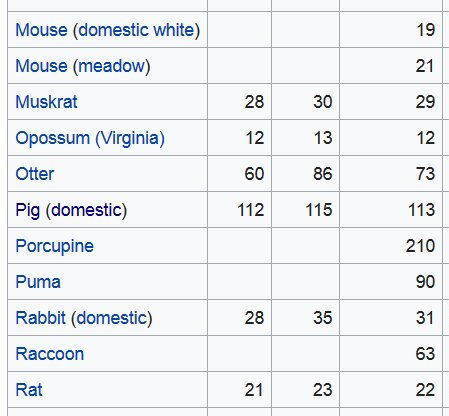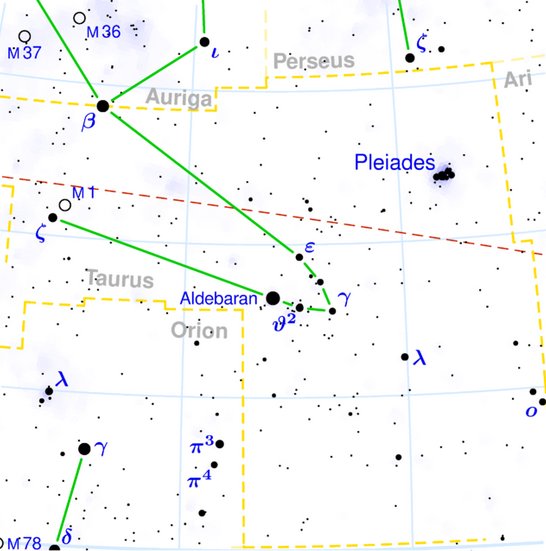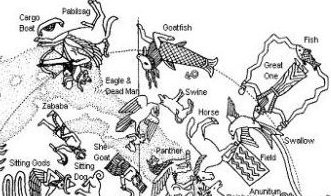From heliacal Bharani to the end of side b on the G tablet there were 23 glyphs.
This number suggests a shift in time-frame from that of Bharani (*41) down to the epoch of the Bull (*64), for the text on side a of the tablet came 64 glyphs after heliacal Sirrah (at the time of rongorongo):
Gb8-30 was the same as Gb8-8 and when moving ahead from the place among the stars which I have defined as "March 21 to that of MARCH 21 (the same date at the time of the Bull) it was necessary not to count the 22 glyphs from puo (covered up) at Bharani to puo at the end of side b. They should be 'covered up' like sweet potatoes (kumara), otherwise the date would not be the same. Puo. (Also pu'a); pu'o nua, one who covers himself with a nua (blanket), that is to say, a human being. Vanaga. 1. To dress, to clothe, to dress the hair; puoa, clothed; puoa tahaga, always dressed. 2. To daub, to besmear (cf. pua 2); puo ei oone, to daub with dirt, to smear. 3. Ata puo, to hill up a plant. Churchill. ... The cycle of the Lono figure on Hawaii stretched for 23 days, equal to the gestation period of the Rat. Day 355 (December 21) - 23 = 332 (November 28): ... The correspondence between the winter solstice and the kali'i rite of the Makahiki is arrived at as follows: ideally, the second ceremony of 'breaking the coconut', when the priests assemble at the temple to spot the rising of the Pleiades, coincides with the full moon (Hua tapu) of the twelfth lunar month (Welehu). In the latter eighteenth century, the Pleiades appear at sunset on 18 November. Ten days later (28 November), the Lono effigy sets off on its circuit, which lasts twenty-three days, thus bringing the god back for the climactic battle with the king on 21 December, the solstice (= Hawaiian 16 Makali'i). The correspondence is 'ideal' and only rarely achieved, since it depends on the coincidence of the full moon and the crepuscular rising of the Pleiades ... Hyadum I (γ Tauri) was at the end of side b of the G tablet and Hyadum II (δ¹ Tauri) was at the beginning of side a:
Perhaps we should understand the crying
out
(shout, ragi) of the
kotake bird - kiakia - as a sign of how
the Sun 'bird' broke through
his confinement ('prison', 'egg shell'):
... Long ago in the very beginning of time there dwelt within a shell an infant god whose name was Ta'aroa. He was Ta'aroa the unique one, the ancestor of all gods, the creator of the universe whose natures were myriad, whose backbone was the ridgepole of the world, whose ribs were its supporters. The shell was called Rumia, Upset. Becoming aware at last of his own existence and oppressed by a yearning loneliness Ta'aroa broke open his shell and, looking out, beheld the black limitless expanse of empty space. Hopefully, he shouted, but no voice answered him. He was alone in the vast cosmos ...
There is an empty glyph space at the beginning of side a, at the place corresponding to Hyadum II (*64) = δ¹ Tauri, which we can compare with the fact that the creators of Manuscript E enumerated only 5 species of banana shoots although there were 6 such on Easter Island. 3 * 314 = 471 (number of glyphs on the G tablet) + 1 = 2 * 236 = 4 * 118 = 8 * 59 = 16 * 29½ = 472. ... And then followed 5 varieties of banana (maika) and 12 varieties of taro [E:67-68] ...
The variant ri'o was missing, possibly in order to draw attention to the empty place at *64, at δ¹ Tauri.
Hyadum I (γ Tauri) was at the last of the 'covered up' (puo) glyphs on side b. Hyadum II (δ¹ Tauri) was at empty glyph place at the beginning of side a - which should not be counted because it was at the day zero ('origo') at the time of the Bull.
The first shell (cell) of confinement for Tagaroa was named Rumia, Upset, and it may have corresponded to Beid (the Egg, ο¹ Eridani) and the 2nd may have corresponded to Hyadum I. ... Within the broken Rumia he grew a new shell to shut out the primeval void ...
... In the inscriptions of Dendera, published by Dümichen, the goddess Hathor is called 'lady of every joy'. For once, Dümichen adds: Literally ... 'the lady of every heart circuit'. This is not to say that the Egyptians had discovered the circulation of the blood. But the determinative sign for 'heart' often figures as the plumb bob at the end of a plumb line coming from a well-known astronomical or surveying device, the merkhet. Evidently, 'heart' is something very specific, as it were the 'center of gravity' ... See Aeg.Wb. 2, pp. 55f. for sign of the heart (ib) as expressing generally 'the middle, the center'. And this may lead in quite another direction. The Arabs preserved a name for Canopus - besides calling the star Kalb at-tai-man ('heart of the south') ... Suhail el-wezn, 'Canopus Ponderosus', the heavy-weighing Canopus, a name promptly declared meaningless by the experts, but which could well have belonged to an archaic system in which Canopus was the weight at the end of the plumb line, as befitted its important position as a heavy star at the South Pole of the 'waters below'. Here is a chain of inferences which might or might not be valid, but it is allowable to test it, and no inference at all would come from the 'lady of every joy'. The line seems to state that Hathor (= Hat Hor, 'House of Horus') 'rules' the revolution of a specific celestial body - whether or not Canopus is alluded to - or, if we can trust the translation 'every', the revolution of all celestial bodies. As concerns the identity of the ruling lady, the greater possibility speaks for Sirius, but Venus cannot be excluded; in Mexico, too, Venus is called 'heart of the earth'. The reader is invited to imagine for himself what many thousands of such pseudo-primitive or poetic interpretations must lead to: a disfigured interpretation of Egyptian intellectual life ...
|
||||||||||||||||||||||||||||||||||||||||||||||||||||||||||||||||||||||||||||||||||||||||||||||||||||||||||||||||||||||||||||||||||||||||||||||||||||||||||||||||||||||||||||||||||||||||||||||||||||||||||||||||||||||||||||||||||||||||||||











